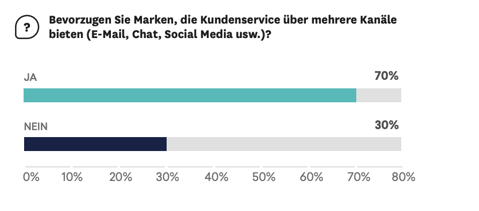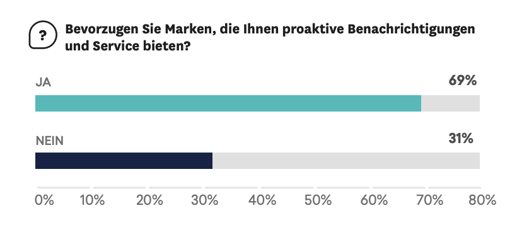Omnichannel and multichannel explained - how to find the right strategy for your customer service
The hype surrounding omnichannel and multichannel in sales and customer support certainly hasn't passed you by, because these two terms are flooding blogs and magazines - and with good reason!
In the following article I would like to explain the differences between "omnichannel" and "multichannel" in customer contact and why this distinction is important for companies. You'll find that the differences aren't as inconspicuous as you might have thought, and you'll also get guidance on which of the two options is better suited to your business.
Omnichannel and Multichannel - What's the difference?
Many dismiss the differences between omnichannel and multichannel as “pure semantics” (the German translation omnichannel and multichannel is less common for both terms). Looking at the meaning of the two prefixes "Omni" and "Multi", their definitions are actually quite close:
Omni: everything / multi: many, numerous
But only superficially do these definitions seem to devolve into a simple discussion of how many channels you use — all or just a lot? But the differences between the multi- and omnichannel approach go much deeper. The following definitions are therefore much more accurate:
Omnichannel: a central perspective that looks at sales, marketing and customer service together and creates a unified brand experience.
Multichannel: Less connected, but still giving your customers multiple ways to find you, buy from you, or get support.
In this context, omnichannel is to be understood as “holistic” or “all-encompassing”, and not just “all channels”.
Customer service: channel-specific vs. holistic
In addition to the fundamental differences between the two concepts, there are also similarities. Both allow you to extend your services and customer service to different channels. For example, you can offer self-service or automated support, better analyze your customer service, or even outsource service options.
As you add features and expand your capabilities, the dividing lines between channels begin to blur. Multichannel approaches build on keeping this to a minimum and making the dividing lines between your support channels as clear as possible. When implemented consistently, the multichannel approach puts your customers in the position of an outside observer and leaves them with the responsibility of finding a solution.
Omnichannel support, on the other hand, uses the interaction of the channels and tries to turn the aftermath into an advantage. The core of this is a consistent customer experience - no matter how often or via which channel a customer contacts your company. This allows you to track every single contact your customers have with your brand and gives your support team access to useful information from previous contacts. The challenge is to provide quality service in each support channel and ensure the focus is on the customer. For this reason, omnichannel customer contact is a significant component of customer success. The more information your support team has at their disposal, the better equipped they are to come up with an appropriate resolution.
 The omnichannel approach therefore puts the customer at the center of your service structure and always orients itself towards their needs when building up experiences, products and support. It therefore goes one step further than the multichannel approach and is therefore to be understood as the next stage in the evolution of customer service.
The omnichannel approach therefore puts the customer at the center of your service structure and always orients itself towards their needs when building up experiences, products and support. It therefore goes one step further than the multichannel approach and is therefore to be understood as the next stage in the evolution of customer service.
Source: Freshworks
Omnichannel customer service needs the right technology
Multichannel has an obvious problem that makes this approach very unsuitable for most companies: If a customer contacts you about the same (or even a completely different topic) through more than one channel, the support agent who made the call accepts or edits the thread, no idea of the content of the previous contact and few opportunities to collaborate with his colleagues on similar tickets. In other words: You start from scratch every time you make contact. And customers become dissatisfied or angry.
On the other hand, if you follow the omnichannel approach, you can, for example, start a conversation on a social network and continue with a phone call. The data and context of the first contact is preserved in the backend and you don't have to reopen the issue with already frustrated customers. This saves time on both sides and makes customers happy.
 So, omnichannel support gives you the power to deliver proactive customer support based on real-time data. However, since you depend on that data, it means you need proper technology running in the background.
So, omnichannel support gives you the power to deliver proactive customer support based on real-time data. However, since you depend on that data, it means you need proper technology running in the background.
Source: Freshworks
Omnichannel creates more efficiency and puts your customer at the center of your brand experience. With every customer contact, you can collect information from your customer experiences and use it to optimize your contact initiation. This, in turn, makes it easier for you to create a cohesive brand experience that unifies marketing, sales, and support.
Being flexible and adapting to customer expectations is an essential prerequisite for the omnichannel approach.
Understand how customers engage with you across each channel and assess your ability to provide a consistent experience. Then you can work with your technology, your channels, and your teams to improve the customer experience.
However, creating a consistent customer experience comes at a price: it forces you to change your work culture and contact processes. And if one of these factors falls by the wayside, it can paralyze your contact channels.
On the other hand, a well-executed omnichannel approach allows you to be dynamic, ROI-focused and interactive. It may take some effort to implement, but the omnichannel approach creates far better customer service than the multichannel approach.
The end result is a more customer-centric company, coupled with a consistent brand experience—regardless of where your customers are contacting you.
Conclusion
Omnichannel and multichannel strategy are not the same - and that's good for your business.
Multichannel communication uses many options for customer contact and support, but does not require a backend that brings the relevant activities together. Omnichannel communication, on the other hand, requires such a backend and can thus combine your channels into a central, helpful customer experience.
This saves your customers and support staff time and frustration, especially when you have a solid helpdesk that makes it easy to get in touch. Additionally, with the omnichannel approach, you can transform your business with more customer centricity, creating an experience that strengthens customer loyalty and will improve your sales over the long term.




